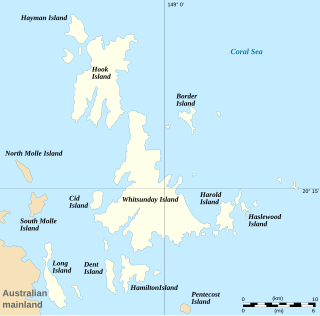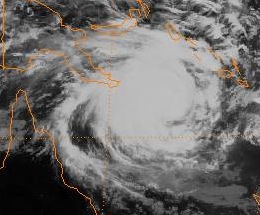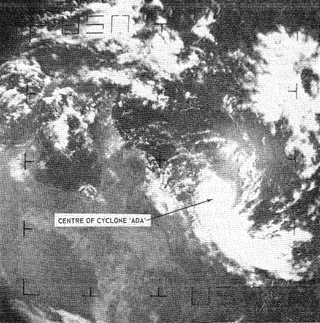
Queensland is a state in north-eastern Australia, the second-largest and third-most populous of the Australian states. It is bordered by the Northern Territory, South Australia and New South Wales to the west, south-west and south respectively. To the east, Queensland is bordered by the Coral Sea and the Pacific Ocean; to its north is the Torres Strait, separating the Australian mainland from Papua New Guinea, and the Gulf of Carpentaria to the north-west. With an area of 1,723,030 square kilometres (665,270 sq mi), Queensland is the world's sixth-largest subnational entity; it is larger than all but 16 countries. Due to its size, Queensland's geographical features and climates are diverse, including tropical rainforests, rivers, coral reefs, mountain ranges and sandy beaches in its tropical and sub-tropical coastal regions, as well as deserts and savanna in the semi-arid and desert climatic regions of its interior.

Green Island National Park is a protected area declared over a small coral cay of Green Island, Cairns Region, Queensland, Australia. It is known to the local Gungganyji Aboriginal peoples as Dabuukji. The Gungganyji people used the island as an initiation ground.

SS Yongala was a passenger steamship that was built in England in 1903 for the Adelaide Steamship Company. She sank in a cyclone off the coast of Queensland in 1911, with the loss of all 122 passengers and crew aboard.

Palm Island is a locality consisting of an island group of 16 islands, split between the Shire of Hinchinbrook and the Aboriginal Shire of Palm Island, in Queensland, Australia. The locality coincides with the geographical entity known as the Palm Island group, also known as the Greater Palm group, originally named the Palm Isles.

Dunk Island, known as Coonanglebah in the Warrgamay and Dyirbal languages, is an island within the locality of Dunk in the Cassowary Coast Region, Queensland, Australia. It lies 4 kilometres (2.5 mi) off the Australian east coast, opposite the town of Mission Beach. The island forms part of the Family Islands National Park and is in the larger Great Barrier Reef World Heritage Area.

Airlie Beach is a coastal locality and resort town in the Whitsunday Region of Queensland, Australia. In the 2016 census, Airlie Beach had a population of 1,208 people.

The Whitsunday Islands are 74 continental islands of various sizes off the central coast of Queensland, Australia, 900 kilometres north of Brisbane. The northernmost of the islands are off the coast by the town of Bowen, while the southernmost islands are off the coast by Proserpine. The island group is centred on Whitsunday Island, while the commercial centre is Hamilton Island. The traditional owners of the area are the Ngaro people and the Gia people, whose Juru people has the only legally recognised native title in the Whitsunday Region.

Sir Reginald Myles Ansett KBE was an Australian businessman and aviator. He was best known for founding Ansett Transport Industries, which owned one of Australia's two leading domestic airlines between 1957 and 2001. He also established a number of other business enterprises including Ansett Pioneer coachlines, Ansett Freight Express, Ansair coachbuilders, Gateway Hotels, Diners Club Australia, Biro Bic Australia and the ATV-0 television station in Melbourne and TVQ-0 in Brisbane which later became part of Network Ten. ATI also bought out Avis Rent a Car and had a 49% interest in Associated Securities Limited (ASL). In late 1979, mainly due to the collapse of ASL, Ansett lost control of the company to Peter Abeles of TNT and Rupert Murdoch of News Corporation who became joint managing directors.
Lindeman Island is an island in the Lindeman Group of the Whitsunday Islands off the coast of Queensland, Australia. The island was named by Captain Bedwell after his sub-lieutenant, George Sidney Lindeman whilst aboard the Royal Navy vessel HMS Virago.

Far North Queensland (FNQ) is the northernmost part of the Australian state of Queensland. Its largest city is Cairns and it is dominated geographically by Cape York Peninsula, which stretches north to the Torres Strait, and west to the Gulf Country. The waters of Torres Strait include the only international border in the area contiguous with the Australian mainland, between Australia and Papua New Guinea.

Daydream Island is one of seven islands of the Molle Group, a sub-group of the Whitsunday Islands in Queensland, Australia. The island is small, measuring 1 km in length and 400 m at its widest point. The highest point on the island is 51 metres above sea level.

Bedarra Island is one of the Family Islands group within the locality of Dunk in the Cassowary Coast Region, Queensland. Australia.

South Molle Island, part of the Whitsunday Islands, is a resort island in the Whitsunday section of the Great Barrier Reef Marine Park in Australia. The hilly island has numerous bays and inlets accessible by 16 km of walking and cycling tracks, with most protected in the Molle Islands National Park.

Severe Tropical Cyclone Justin was a tropical cyclone of the 1996–97 Australian region cyclone season that caused seven deaths and had a major economic impact in northern Queensland, Australia. It had a long 3+1⁄2-week life from 6 March to 24 March 1997. Peaking as a Category 3 cyclone and making landfall as a Category 2, it caused significant damage in the Cairns region, which it approached on two occasions. Houses were undermined by huge waves, a marina and boats were severely damaged, roads and bridges suffered from flood and landslide damage and huge losses were inflicted on sugar cane, fruit and vegetable crops. The death toll in Queensland was seven including five on a yacht which sank. There were 26 who died in Papua New Guinea, which was also severely affected. Total estimated costs from damages in Australia were $190 million.

Severe Tropical Cyclone Hamish was a powerful tropical cyclone that caused extensive damage to the Great Barrier Reef and coastal Queensland, Australia, in March 2009. The eighth named storm of the 2008–09 Australian region cyclone season, Hamish developed out of an area of low pressure on 4 March near the Cape York Peninsula. The storm rapidly developed into a Category 1 cyclone on the Australian intensity scale the next day. On 6 March, an eye developed, and Hamish strengthened into a Category 3 cyclone. Deep convection developed around the eye, fueling further intensification, which allowed the storm to become a Category 5 tropical cyclone late on 7 March. Hamish made its closest approach to land on 8 March, but continued moving southeastward. Eventually, the cyclone weakened and turned back towards the northwest, weakening into a remnant low on 11 March, before finally dissipating on 14 March.

The 1969–70 Australian region cyclone season was an above-average tropical cyclone season. It ran from 1 November 1969 to 30 April 1970. The regional tropical cyclone operational plan also defines a "tropical cyclone year" separately from a "tropical cyclone season", with the "tropical cyclone year" for this season lasting from 1 July 1969 to 30 June 1970.
The Ngaro are an Australian Aboriginal group of people who traditionally inhabited the Whitsunday Islands and coastal regions of Queensland, employing a seafaring lifestyle in an area that archaeologically shows evidence of human habitation since 9000 BP. Ngaro society was destroyed by warfare with traders, colonists, and the Australian Native Police. The Native Police Corps forcibly relocated the remaining Ngaro people in 1870 to a penal colony on Palm Island or to the lumber mills of Brampton Island as forced labourers.

Hamilton Island is an island of the Whitsunday Islands in Queensland, Australia. It is approximately 887 kilometres (551 mi) north of Brisbane and 512 kilometres (318 mi) south of Cairns.

A resort island is a hotel complex located on an island; in many cases one luxury hotel may own the entire island. More broadly, resort island can be defined as any island or an archipelago that contains resorts, hotels, overwater bungalows, restaurants, tourist attractions and its amenities, and might offer all-inclusive accommodations. It primary focus on tourism services and offer leisure, adventure, and amusement opportunities.

Severe Tropical Cyclone Ada was a small but intense tropical cyclone that severely impacted the Whitsunday Region of Queensland, Australia, in January 1970. It has been described as a defining event in the history of the Whitsunday Islands, and was the most damaging storm in the mainland town of Proserpine's history at the time. Forming over the far eastern Coral Sea in early January, the weather disturbance that would become Ada remained weak and disorganised for nearly two weeks as it slowly moved in a clockwise loop. Accelerating toward the southwest, the system was named Ada on 15 January. All observations of the fledgling cyclone were made remotely with weather satellite imagery until it passed over an automated weather station on 16 January. The extremely compact cyclone, with a gale radius of just 55 km (35 mi), intensified into a Category 3 severe tropical cyclone just before striking the Whitsunday Islands at 14:00 UTC on 17 January. At 18:30 UTC, Ada's eye crossed the coast at Shute Harbour. The cyclone made little inland progress before stalling northwest of Mackay and dissipating on 19 January.























